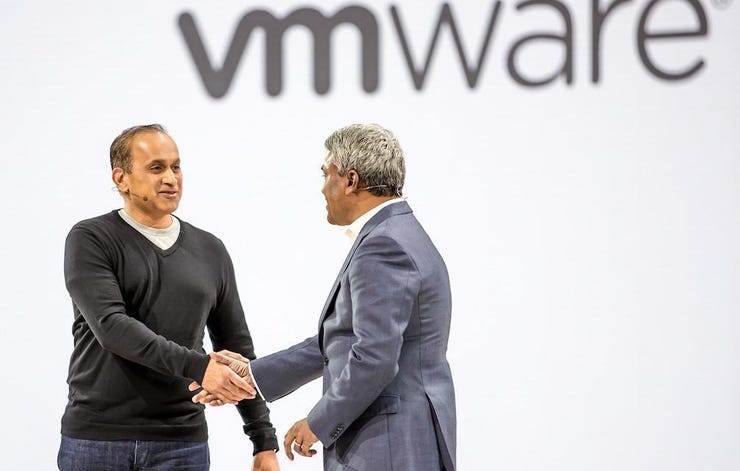Google Cloud wants to lift and shift your existing workloads


Google Cloud CEO Thomas Kurian and VMware COO Sanjay Poonen at last year's Google NEXT
A core pillar of Google Cloud's appeal was providing enterprises access to the same technologies that Google itself uses. In many cases, such as with data platforms such as BigQuery or Spanner, getting the most out of them required that customers change the way they structured their databases or formed queries by doing it Google's way.
But Google Cloud CEO Thomas Kurian also wants to make GCP hospitable to lifting and shifting your existing workloads. Google is following in the footsteps of rivals such as AWS and Azure that are offering services to meet enterprise customers where they live – at least when it comes to application architecture. The strategy might best be characterized as "if you can't beat them, join them."
In recent weeks, Google has announced a series of services aimed at moving those workloads to Google Cloud without change through a series of services, and that is part what they are highlighting at the "on-air" edition of Google NEXT this week. Headlining is the announcement of general availability of Google Cloud VMware Engine, part of a VMware partner strategy that was first disclosed last summer. It's based on running VMware's Software-Defined Data Center (SDCC) that leverages the recently acquired CloudSimple VMware migration environment.
The Google/VMware engine is a GCP-native managed implementation of the SDDC stack, including vSphere, vSAN, NSX-T, and HCX in its own dedicated environment. It means that you can take your existing VMware environment and have it natively managed in Google Cloud, on Google Cloud infrastructure, without having to convert your VMs into containers. Of course, an added attraction once you've moved workloads there is ready access to GCP's own services such as BigQuery.
As noted, Google is not the first to get there. Back in 2016, AWS planted its stake in the ground with its VMware partnership that has since resulted in the release of a number of offerings encompassing a VMware-managed SDDC service in the AWS public cloud, an edition of that running in AWS's Outposts hybrid cloud platform, and even a VMware offering for running AWS RDS (MySQL and PostgreSQL) services managed jointly by VMware and AWS, on commodity (not AWS) hardware, on the customer's premises. Google maintains that it is playing leapfrog – maybe they weren't the first, but for now they offer nodes with more memory and storage access across all hyperscalers (another term for scale-out cloud infrastructure).
In related announcements, Google Cloud is announcing bare metal instances for Oracle database, which is now generally available in five regions. Formerly president of Oracle, it would be tempting to characterize this as Kurian's grudge match. Regardless, the overriding strategy of the bare metal Oracle offering is the same as with VMware: meet customers where they are.
The similarity between GCP's bare metal Oracle service and the VMware engine extends to the fact that both services are abstracted from the way most GCP services are run – but there are subtle differences. The VMware engine runs on common compute in GCP, but a separate control plane, whereas with the bare metal Oracle service, it's the reverse.
As the name implies, the Oracle service is bare metal, meaning it is not virtualized or multi-tenanted with other GCP services. It is aimed at enterprises running Oracle databases that also want the operational simplification of having a cloud provider manage all the housekeeping, deployment, and perimeter security. There are parallels with AWS's RDS implementations of Oracle, which Amazon also manages, but the difference here is provision of a single-tenanted, dedicated instance. The obvious competition is with Oracle Public Cloud, which differentiates by offering the most recent releases of the Oracle database and the autonomous database.
Rounding out the announcements, GCP is making several announcements related to certifications for SAP HANA and SAP application workloads. They include larger scale-up instances for SAP HANA databases, with up to 6 TBytes for OLAP and 12 TBytes for OLTP. For now, GCP's upper limits are dwarfed by those of AWS, which offers scale-up instances for 18 TBytes for OLAP (analytics) and 24 TBytes for OLTP. Nonetheless, treat this announcement as Google's opening shot. SAP itself has been spreading the wealth, with its Embrace program for S/4HANA with Azure. For GCP, SAP recently announced that its data center in Frankfurt would run on Google Cloud.
And while we're talking about SAP, Google is also announcing a "Cloud Acceleration Program" with leading integrators such as Deloitte and Accenture for developing jumpstart migration templates for moving classic SAP applications to Google Cloud.